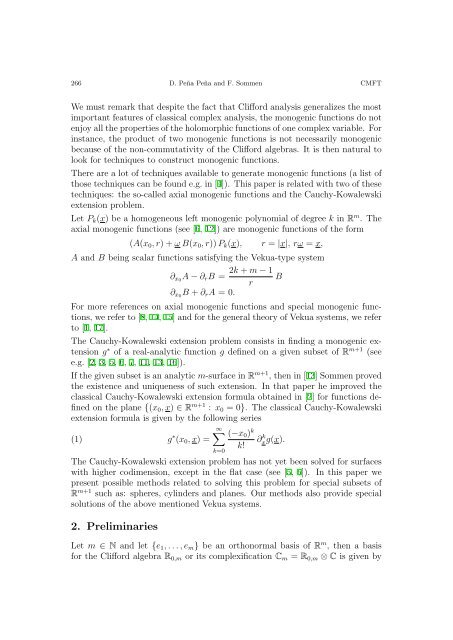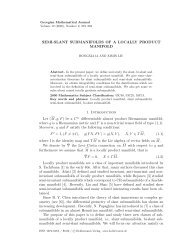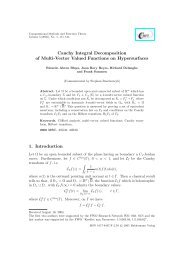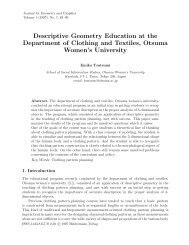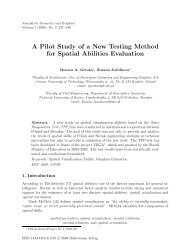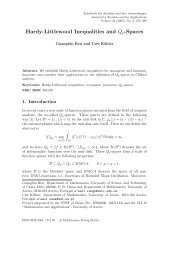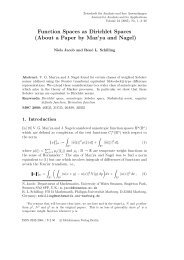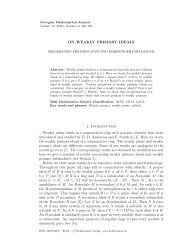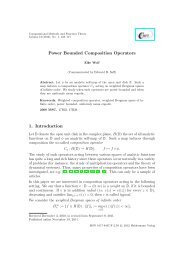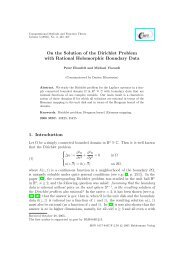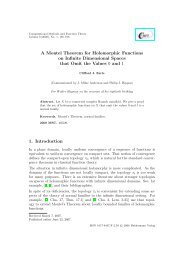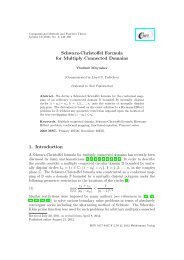Some Power Series Expansions for Monogenic Functions in
Some Power Series Expansions for Monogenic Functions in
Some Power Series Expansions for Monogenic Functions in
Create successful ePaper yourself
Turn your PDF publications into a flip-book with our unique Google optimized e-Paper software.
266 D. Peña Peña and F. Sommen CMFT<br />
We must remark that despite the fact that Clif<strong>for</strong>d analysis generalizes the most<br />
important features of classical complex analysis, the monogenic functions do not<br />
enjoy all the properties of the holomorphic functions of one complex variable. For<br />
<strong>in</strong>stance, the product of two monogenic functions is not necessarily monogenic<br />
because of the non-commutativity of the Clif<strong>for</strong>d algebras. It is then natural to<br />
look <strong>for</strong> techniques to construct monogenic functions.<br />
There are a lot of techniques available to generate monogenic functions (a list of<br />
those techniques can be found e.g. <strong>in</strong> [4]). This paper is related with two of these<br />
techniques: the so-called axial monogenic functions and the Cauchy-Kowalewski<br />
extension problem.<br />
Let P k (x) be a homogeneous left monogenic polynomial of degree k <strong>in</strong> R m . The<br />
axial monogenic functions (see [6, 12]) are monogenic functions of the <strong>for</strong>m<br />
(A(x 0 , r) + ω B(x 0 , r)) P k (x), r = |x|, rω = x,<br />
A and B be<strong>in</strong>g scalar functions satisfy<strong>in</strong>g the Vekua-type system<br />
∂ x0 A − ∂ r B = 2k + m − 1 B<br />
r<br />
∂ x0 B + ∂ r A = 0.<br />
For more references on axial monogenic functions and special monogenic functions,<br />
we refer to [8, 14, 15] and <strong>for</strong> the general theory of Vekua systems, we refer<br />
to [1, 17].<br />
The Cauchy-Kowalewski extension problem consists <strong>in</strong> f<strong>in</strong>d<strong>in</strong>g a monogenic extension<br />
g ∗ of a real-analytic function g def<strong>in</strong>ed on a given subset of R m+1 (see<br />
e.g. [2, 3, 5, 6, 7, 11, 13, 16]).<br />
If the given subset is an analytic m-surface <strong>in</strong> R m+1 , then <strong>in</strong> [13] Sommen proved<br />
the existence and uniqueness of such extension. In that paper he improved the<br />
classical Cauchy-Kowalewski extension <strong>for</strong>mula obta<strong>in</strong>ed <strong>in</strong> [2] <strong>for</strong> functions def<strong>in</strong>ed<br />
on the plane {(x 0 , x) ∈ R m+1 : x 0 = 0}. The classical Cauchy-Kowalewski<br />
extension <strong>for</strong>mula is given by the follow<strong>in</strong>g series<br />
∞∑<br />
(1) g ∗ (−x 0 ) k<br />
(x 0 , x) =<br />
∂ k<br />
k!<br />
xg(x).<br />
k=0<br />
The Cauchy-Kowalewski extension problem has not yet been solved <strong>for</strong> surfaces<br />
with higher codimension, except <strong>in</strong> the flat case (see [5, 6]). In this paper we<br />
present possible methods related to solv<strong>in</strong>g this problem <strong>for</strong> special subsets of<br />
R m+1 such as: spheres, cyl<strong>in</strong>ders and planes. Our methods also provide special<br />
solutions of the above mentioned Vekua systems.<br />
2. Prelim<strong>in</strong>aries<br />
Let m ∈ N and let {e 1 , . . . , e m } be an orthonormal basis of R m , then a basis<br />
<strong>for</strong> the Clif<strong>for</strong>d algebra R 0,m or its complexification C m = R 0,m ⊗ C is given by


